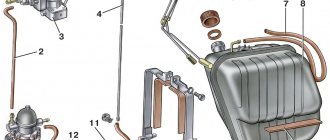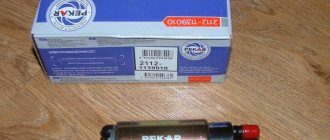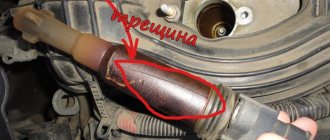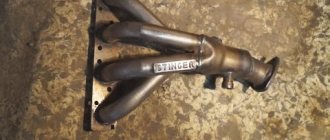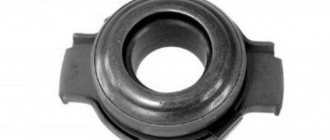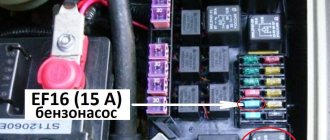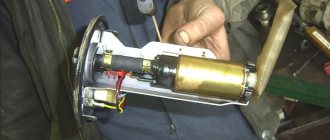Tips for motorists
On the Lada Priora passenger car, as on other cars with an injection engine, the operating algorithm of the electric fuel pump is as follows:
- as soon as the driver turns on the ignition, he should hear within 3-4 seconds the noise of the fuel pump starting, which raises the gasoline pressure in the fuel rail so that the engine can start normally;
— after the pressure in the fuel rail rises, the fuel pump turns off;
— next, the driver turns the ignition key to the “starter” position, as a result of which the engine crankshaft begins to rotate and the crankshaft position sensor (CPS) is immediately activated, the pulses of which go to the electronic control unit (ECU);
— The ECU, in turn, turns on the relay, when the contacts of which are closed, voltage is supplied to the terminals of the fuel pump and if it is working properly, it will begin to perform its function, which is to supply gasoline from the tank to the fuel rail;
— and if the crankshaft stops rotating, the DPKV will stop sending pulses to the ECU, which will de-energize the relay, its contacts will open and the fuel pump will stop working;
Knowing this algorithm, it is much easier for the driver to find a malfunction as a result of which the fuel pump refuses to work. But it is worth adding that all electrical circuits are protected by fuses and troubleshooting usually begins with checking them. Considering that there are two options for turning on the fuel pump: the ignition key in the “ignition on” position and the ignition key in the “starter” position. Then you will have to check two fuses, which are located in the side of the tunnel on the front passenger side.
When the ignition is turned on, electric current from the battery flows through fuse F1 (15 A) into the circuit of the main relay K1, which supplies plus to the coil of the fuel pump relay, as a result of which its contacts are closed and voltage is supplied to the terminals of the fuel pump. After a few seconds, the controller, having collected the necessary information, turns off the main relay, and since the electric current went to the fuel pump through it, the fuel pump naturally turns off. And when the ignition key is turned to the “starter” position, the electric current from the battery flows through fuse F3 (15 A), and the fuel pump relay K2 turns on the ECU, according to the DCPV signal. That is why the driver needs to check both fuses.
If at least one of the above devices fails, even a working fuel pump will not work. You can check the condition of the fuel pump itself by applying voltage to its terminals directly from the battery.
Hi all! Quite a long time ago, when I went for diagnostics, the technicians said that my Priora had low pressure in the ramp. I didn’t do it because... the breakdown was not fatal, and there were no funds at that time. And literally, in the last three days my car has barely started, about the 7th time. I turn on the power, the fuel pump runs for a second and turns off, I start to start it - whoosh! Once again - the same bullshit! The third time the fuel pump doesn’t turn on at all... the sixth time I help with the gas pedal and the seventh time it starts! I rushed to the garage, removed the fuel pump, shook the wiring, washed the filter, installed it... nothing has changed!
I got into the fuses and relays.
Then, I noticed that the fuel pump works perfectly when the car is running; as soon as I turn it off and turn on the power, there is zero response. And yet, the immobilizer (yellow car with a key) starts flashing on the instrument panel.
I went online on my phone... I came across a lot of articles where people write that a bolt on a key with buttons may be overtightened. What the hell is this? Could the car not start because of a bolt on the key?! I decided to try...I loosened the bolt and...OH GODS! The pump hummed and the car started! Coincidence? Believe it or not! They write that the soldering is bad and over time something jams and the immobilizer does not see the key. Unscrewed it, cleaned it. Now I’m thinking about cutting out the rubber gasket so as not to snap the two halves of the key together. Or just buy a new key.
Why may the starter not turn?
If the start occurs in a cold or frosty environment, then several attempts should be made before starting to troubleshoot. In case of a complete fiasco, when when you turn on the relay clicks and the indication on the panel goes out, you need to do the following:
- make sure the battery is charged;
- check whether all the wires coming from the battery are cold - the presence of heating indicates poor contact (the terminals need to be cleaned);
- see whether the battery connectors are securely connected to the ground, and whether it is securely connected to the body of the car (existent contaminants are eliminated);
- make sure that the plus on the starter contact is holding well.
The traction relay is disconnected from the wiring if there is doubt about the normal operation of the ignition switch. Then the key is set to start, and a multimeter is used to check the presence of voltage directly at the removed connector.
When none of the above helps, you will need to dismantle the starter itself.
The fuel pump does not work on the Lada Priora: reasons
In a situation where the fuel pump on a Lada Priora car does not work, the causes of the problem are not so difficult to detect. But if a problem occurs somewhere along the road, then without fixing the problem you will not be able to continue your journey and you will have to look for a way to tow the car to the nearest service station. But not all faults related to the fuel supply are fatal; some of them can be detected and eliminated independently.
see also
Comments 21
It’s inexplicable, but it’s a fact, thank you very much for the information! This is exactly how the car was 'repaired'! I’m shocked, but everything starts up clearly after a loose screw, I suffered for three weeks, it started up only once since the 20th.
Tell me, the Priora suddenly stopped starting, when you turn on the ignition, the relay clicks on the starter, but on the BN there is silence, the fuses are all intact, I changed the relay and the starter does not turn
Scribe...I'm in ah wow...I also tried everything and nothing worked...and so I loosened this bolt and f.b.a.n.u.t.y.s.ya. EARNED
Hello guys! If anyone has encountered this, the problem is the following: the fuel pump does not pump when you turn on the ignition, the relay does not click, I set it to work, nothing changes, the fuse is intact, I reset the battery terminal, it pumps three times, but the car does not start, it tries, as if it’s seizing , but no, I installed a jumper instead of the fuel pump relay, it buzzes, but does not start
Tell me, what if it’s a simple standard key?
In fact, the bolt loosened and stopped glitching.)) I was at fault with the immobilizer, but I didn’t understand what was going on)) I turned the key 10-15 times back and forth to start, sometimes it would start the second time, the relay would turn off and that’s it. And thank heavens
Source of the article: https://xn—-8sban6b6a.xn--p1ai/remont/niva-inzhektor-ne-rabotaet-benzonasos.html
Location and operation of the fuel pump
The fuel pump in the Lada Priora car operates from an electric drive, which is turned on after turning the key to the ignition position. Within a few seconds, it pumps fuel into the fuel system so that the pressure in it reaches 3.7 bar, while a characteristic low buzzing sound is heard inside the cabin. When the pressure mark is reached, you can start the engine.
The unit works continuously, just because of the noise of the motor, the sound made by the pump is no longer audible. A special RTD regulator with a bypass valve maintains the required pressure in the fuel line.
The whirring of the fuel pump can be heard inside the car because it is located inside the fuel tank, located under the rear seat of the Priora. There is also a built-in fuel coarse strainer and a level sensor with a float. Gasoline pumped by the pump is supplied to the injectors through a fuel line tube made of thick-walled copper tube.
Symptoms of unit malfunction
Malfunctions of the Priora fuel supply pump can manifest themselves in different ways.
Sometimes it fails completely, in other cases it maintains too low pressure in the system. Symptoms of problems are:
- after turning the key in the ignition switch, the characteristic sound of the fuel pump is absent, and the engine does not start;
- when the ignition is turned on, the pump pumps, the power unit starts, but when you try to move away, the engine stalls and starts with difficulty;
- The car jerks while driving, stalls and does not want to start.
The first symptom indicates a malfunction in the electrical circuit that supplies power to the unit. Also, a complete failure may be the result of a breakdown of the pumping device itself, and it has to be replaced. Fortunately, such breakdowns are quite rare. Electric fuel pumps installed on VAZ cars are considered quite reliable devices and operate without problems for 150-200 thousand km.
The remaining 2 symptoms indicate that the amount of fuel supplied to the injectors is not enough for normal driving. If the car somehow starts and idles, then there is no longer enough fuel to move. Since the characteristic symptoms of low pressure in the line are similar to the symptoms of problems with other units and systems, it is necessary to carry out diagnostics and more accurately determine the cause.
Checking the fuel pump Lada Kalina/Granta
If after turning the ignition key there is no buzzing sound from the fuel pump, then the first thing to check is the fuel pump fuse and relay. In the Lada Kalina and Lada Granta mounting block, the fuel pump fuse is F21 (15A), and the fuel pump relay is K12. If the fuse is good, do the following:
- Turn on the ignition
- Remove the fuel pump relay
- Apply +12V to pin No. 11 of the diagnostic block, or place a jumper between 87 and 30 relay pins
- Check by ear that the fuel pump is turned on
If the fuel pump does not turn off, then check:
- Wiring and contacts between the fuel pump and the diagnostic block/fuel pump relay. To do this, check the voltage at the fuel pump chip using a test lamp or multimeter.
- There is no connection between the fuel pump and the vehicle ground. Apply the mixture to the fuel pump (located under the rear seat).
- The fuel pump is faulty. To check it, apply +12V directly to the contacts of the fuel pump (Attention! Remaining gasoline may ignite from a spark!).
In rare cases, the fuel pump does not work due to:
- ECU (controller) malfunction
- alarm malfunctions
Often, the device for supplying fuel to the engine does not work on a car, due to the fact that the mesh is clogged, or the fuel filter is clogged - they block the path of flammable substances along the highways, so that the engine actually has nothing to work with. In such cases, it will be enough to change the filter. But malfunctions of the fuel pump of a Priora car can manifest themselves in different ways:
- After the key in the ignition switch is turned until the ignition is turned on, there is no characteristic pumping sound. Under ideal conditions, you should always wait until the pump pumps fuel and then start the engine. Simply put: the car’s fuel pump does not work and does not pump fuel. Fuel pump electrical circuit malfunction.
- When you turn on the ignition, you can hear the pump pumping fuel to the car, and the engine starts. But as soon as the driver tries to drive just a little bit, the car stalls. When the car is stationary (idling), it consumes less fuel in each cycle. And when it starts moving (even without pressing the gas pedal), a larger volume of liquid is required, but it does not flow to the injectors. The pump does not have time to pump up gasoline.
- When driving, the car “nods” and then stalls. To maintain a stable speed when driving, as well as for acceleration, the gas pump must periodically supply a larger volume of flammable substance. If he cannot do this, the engine “chokes” on air - it needs gasoline.
In the last two cases, you will most likely have to replace the mesh of the device for supplying fuel to the engine. In the worst case scenario, it will be replaced.
In short, this has never happened, this morning I started it up to warm it up and left, when I came back it didn’t work, I tried to start it, but when I turn the starter the fuel pump relay clicks very often and you can hear the fuel pump turning on/off, the engine naturally picks up but doesn’t start. In general, I ran to the Internet to look, came back 20 minutes later and oops! I started up as if nothing had happened, I ride all day and not a single glitch. Tomorrow I have a long drive, so I want to find out what it was, maybe the relay is dull, maybe the contact group, I exclude the signaling, because... She doesn't know how to block my fuel pump.
Last edited by sanbol; 01/16/2015 at 01:16.
Maybe it's time to change the fuel pump relay.
maybe it’s just how many cars I’ve had, so the relay usually gets stuck due to a bad contact or doesn’t work at all, but I removed the contacts in the mother’s place and the relay is also fine. I also forgot to say, at the moment the relay clicked, the check light came on, i.e. The engine starts, but it jerks and tries to stall, the relay clicks and the check engine light blinks.
sanbol
, Well, just to reassure yourself, look at the fuel pump power supply chip, maybe there is a bad contact there. I doubt it, but purely to rule out this option. Still, it’s better to take a spare relay with you.
So are you excluding the contact group?
sanbol
, I can’t say with 100% certainty. Here is the link: https://www.nexia-faq.ru/remont/kontakt-group.html Here is the most important thing we need:
There are 5 contacts on the contact group of the Nexia ignition switch: “30” - power from the battery “15” - ignition “15a” - heater fan “50” - starter “Kb” (“Ka”) - radio
Diagnosis and Troubleshooting
It is relatively simple to verify that the electrical network is faulty - this can be done without removing the fuel pump. When the sound of its operation is not heard when the ignition is turned on, you must immediately check the fuse responsible for this circuit. It is installed in a block mounted at the bottom in front of the front passenger seat. You need to remove the block cover, find the fuse marked F3, rated for 15 A, and replace it. This kind of work can be done on the road.
If the operation of the fuel pump has not resumed, you should switch your attention to relay K2, located in the same block. It closes the power circuit of the pumping device based on a signal from the controller. You can also check the serviceability of the relay in road conditions, for which you will need a piece of copper wire. Diagnostics are carried out in the following order:
- Remove relay K2 from the connector.
- Turn on the ignition.
- Using a wire, connect the contacts marked “30” and “87”; the numbers are marked on the relay. Another option is to apply power to pin “11” located in the diagnostic connector. The +12 V voltage can be taken nearby, from the cigarette lighter.
- If you hear the pump humming, then you need to change relay K2.
Starter operating principle
This device itself is a conventional electric motor. A gear is installed on it, which meshes with the flywheel, which rotates when the power unit starts. A traction relay is also attached to the housing. The functions of this element include:
- gear movement control;
- starter disconnection.
When the key is turned to the starting position, voltage is supplied to the relay, exciting the electromagnet windings, then the contacts close. At the same time, the gear begins to rotate and the motor starts.
Gasoline pump
The Priora fuel pump is a kind of electric DC motor in the form of a cylinder. Inside the pump there is a shaft on which an impeller is rigidly mounted that pumps fuel into the system and a check valve that does not allow the fuel to lose pressure in the system after the pump stops.
The operating pressure in the system that the pump must maintain is in the range of 3.6-4.0 bar. If there is a loss of pressure in the system, the engine will operate unstably, losing speed and detonating.
The fuel pump cannot work alone, so it is part of the fuel cup of the fuel pump. This glass contains all the necessary elements for pressurizing the fuel system.
The fuel pump capacity according to the manufacturer’s requests is from 60 l/h.
Where is the fuel pump located
The Priora fuel pump is located in the fuel tank. It is accessible under the rear seat of the car. When you remove the seat, you can find a hatch underneath it, which is secured with two screws. After unscrewing the screws and dismantling the cover, you can see the upper part of the fuel pump glass. The glass is attached to the tank with nuts through a metal ring and a rubber gasket, on 8 studs.
The fuel pump glass has:
- Fuel pressure control;
- Fuel pump;
- Fuel level sensor;
- Coarse fuel filter;
- Sump (bucket);
Price
Below are the prices and part numbers for the fuel pump, depending on the manufacturer.
| Manufacturer | vendor code | Price, (rubles) |
| Bosch | 2112-1139009 | 2000 |
| SOATE | 60.1139-01 | 1100 |
| RES | 0588455055 | 900 |
The table below shows the elements of the fuel cup and their prices, taking into account the manufacturer.
| Detail | vendor code | Price, (rubles) |
| RTD | 11180-1160010-00 | 480 |
| Hose | 21083-113902200 | 30 |
| Mesh | 21101-113920000 | 30 |
| The cost of a complete fuel pump glass starts from 2,400 rubles. Article: 21101-1139009 |
Priora fuel pump fuse
The Priora fuel pump fuse is not located in the standard location for all fuses. It is located at the front passenger's feet, under the footwell air duct cover.
The red oval shows the fuel pump fuse
Rated current of this fuse = 15A, number F3;
It is strictly prohibited to install fuses with a rating higher than specified.
How to check the fuel pump yourself
| The car won't start, but when you turn the ignition key you can't hear the fuel pump running? Don’t rush to replace it with a new one; it’s better to first find out how to check the operation of the gas pump yourself. |
Procedure: 1. Checking the fuel pump fuse. This is where you should start checking the fuel pump. On a VAZ 2110 it is located near the left foot of the front passenger.
2. How to check the fuel pump relay. The relay is located next to the fuse, so let's check that right away. We check the voltage at the control terminals one by one (87, 86 and 85 in turn), and touch the ground with the other end. The testing tool can be a multimeter or a test lamp with a current consumption of no more than 0.25A. If the lamp does not light and the fuse is good, then we check the wiring and serviceability of the ECU.
Sometimes they check differently, for example, instead of a relay, they connect a test lamp between pins 85 and 86. When the ignition is turned on, the lamp should light up. You can also place a jumper between pins 87 and 30. Does the fuel pump start when you turn the key? This means the relay is faulty. You can also check the fuel pump relay by replacing it with a known good relay.3. How to check if the fuel pump is working. Without removing it, we check the voltage on its chip using a test lamp or multimeter.
Reasons for the fuel pump not pumping
Quite often it happens that the Priora fuel pump simply stops pumping fuel. There are many reasons for this problem, but in order to find them you need to understand what can affect the performance of the fuel pump. Below are all the reasons why the pump may stop pumping fuel into the system.
Fuse
It often happens that the fuse blows under load and breaks the power supply circuit to the fuel pump. As a result, the fuel pump cannot work. The fuse needs to be checked.
The relay is directly responsible for the operation of the fuel pump, thereby turning off the operation of the pump if it fails. It happens that the contacts on the relay oxidize or the coil burns out, which leads to the pump stopping and the inability to pump pressure into the system.
Filter
Fuel filters, fine and coarse filters are clogged. They need to be checked, or at best replaced.
Gasoline pump
It is also possible that the fuel pump itself may fail. Due to aging or poor quality fuel. You can read how to check the fuel pump in our article.
Reasons for failure of the starting system
Most often the following happens:
- For some reason the electric starter does not turn on - the reason is a broken wiring, short circuit or breakdown of the traction relay;
- the starter starts, but an uncharacteristic clicking sound is heard - damage to the coil of the above relay or discharge of the battery;
- the start works, but the starter does not turn or rotates too slowly - the battery is dead.
In addition, the reason here may lie in:
- loss of contact;
- brush wear;
- collector contamination;
- short circuit of the winding wires.
It also happens that the starter works normally, but the flywheel still does not rotate.
Here, first of all, you need to make sure that the attachment to the crater installed on the clutch is not broken. Then you will have to check the integrity of the teeth of the flywheel itself or the drive gear.
It happens that the 16-valve Priora does not turn off the starter after the power plant is factory installed. This happens due to a malfunction of the clutch that ensures the free movement of the unit in question. Sticking of the relay contact group also leads to the same result. If this malfunction occurs, you must immediately turn off the engine.
Problems with the Priora plant often arise due to ignition failure. In this case, you need to make sure that:
- the coils are securely fastened to the power plant;
- there was no break in the ignition wires in its low-voltage circuit;
- whether the spark plugs are working (if there is no spark, you will need to replace the ignition coil).
And finally, it is impossible to start the engine if there is a breakdown in the power system. You will need to check the air filter. If it is not clogged, you need to inspect the connector contacts in the injection system (do not forget to also look at the fuel pump - if it does not make noise, then most likely there are problems with the electrical network) and make sure that the fuel pressure is normal.
Before performing the steps mentioned above, be sure to disconnect the negative connector on the battery. This should only be done with the ignition off.
Signs of a fuel pump malfunction
There are several signs of a fuel pump that predict its imminent failure. If you notice such symptoms in your car, it is recommended not to delay replacing the pump, but to carry it out immediately.
- The car engine did not start the first time;
- It is necessary to turn the starter much longer than usual;
- Dips when moving at a constant speed;
- Jerks when moving;
- The former dynamics have disappeared;
- A strong squeak of the pump is heard when the internal combustion engine is running;
Replacing the fuel pump
The process of replacing the fuel pump is a simple task if you follow the instructions below. To complete the job faster and easier, you need to prepare a tool for the job.
- Open-end wrench 10mm;
- Ratchet with 10mm head;
- Phillips screwdriver;
- Rags;
You should also prepare consumables that need to be replaced along with the fuel pump.
- Fuel pump mesh;
- Fuel filter;
- Corrugated fuel hose;
- Rubber sealing ring (according to condition);
Step-by-step instruction:
- We remove the rear sofa in cars with a sedan body, in hatchback and station wagon bodies, just fold back the right side of the sofa.
- Unscrew the two screws securing the cover and remove it. Blow or sweep away the dust that has formed around the glass. Necessary to protect against dirt getting into the fuel tank.
- Remove the fuel pump fuse and start the car. This will relieve residual pressure in the fuel rail. We wait until the car stalls.
- We disconnect the negative mark from the battery, since the work is carried out with flammable substances (gasoline) and electrical appliances of the car.
- Remove the connector from the fuel pump housing. Remove the plastic fittings. A little fuel may spill, there is nothing to worry about.
- Let's start disassembling the pump
- Remove the stoppers securing the glass sump. And disconnect the sump from the glass.
- We remove the fuel pump from its seat, disconnecting the fuel corrugated hose (if necessary, the hose must be replaced).
- We install a new fuel pump with a new fuel pump strainer installed in the reverse order.
How to remove the electric starter
The procedure in this case is as follows:
- remove the terminals from the battery;
- the “plus” connector is removed from the starter;
- removed from the relay block;
- The nuts securing the faulty unit are unscrewed.
Then you can safely remove it.
Next you will need to check the functionality of the relay. To do this, take emergency wires to start from another car. The negative one is installed on the battery and on the starter housing. “Plus” is connected to the relay. The latter in this case (if it works properly) is triggered and moves the gear. The absence of this reaction indicates a breakdown of this element.
When there is no reason to suspect the relay, you need to try to start the starter itself. The “minus” remains in place, and the “plus” is set to the lower output of the relay. The motor should start working. A negative result indicates wear of the graphite brushes.


